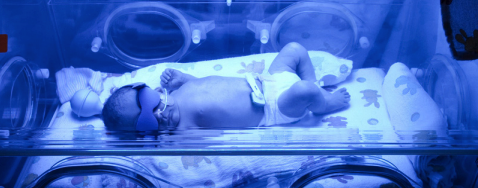Neonatal Hyperbilirubinemia
Key Words
Paediatrics, Acute Care, Patient Deterioration, Monitoring, Patient/Family Escalation, Jaundice, Neonatal Hypoglycemia, Situation Awareness, Team Communication, Neonatal Seizures
Abstract
A term infant sustained hypoglycemic brain injury while receiving in-hospital therapy for jaundice. The team’s failure to acknowledge/investigate the parent’s concerns were identified as a key contributing factor.

On the second day following birth, the infant was noted to be jaundiced. Phototherapy was started, with the infant being transferred to the Special Care Nursery. Upon admission, the infant was noted to be lethargic, with a temperature of 36.7 degrees Celsius and blood glucose of 2.1 mmolL.
Several hours later, the involved nurse noted suspected seizure activity, observing eye blinking, tongue thrusting and cycling movement of the arms and legs. A septic work-up was ordered and the infant was subsequently started on phenobarbital.
Following the initiation of phenobarbital, the infant continued to exhibit seizure activity, prompting the initiation of dilantin. Due to ongoing seizure activity, the decision was made to transfer the infant to a specialized paediatric facility. Magnetic resonance imaging (MRI) results obtained after the transfer were consistent with hypoglycemic brain injury.
Medical legal findings
Expert review of the case was critical of the care provided to the infant. A review of the infant’s medical record revealed that following birth significant feeding difficulties were encountered, necessitating the implementation of supplementation with breastfeeding. Furthermore, the infant’s medical record confirmed that prior to the infant’s transfer to the Special Care Nursery, the infant’s mother had expressed concerns to the nurses and physicians (which they had no memory of) with regard to the infant’s jitteriness, high-pitched cry and lethargic appearance. It was suspected that the nurses failed to recognize the clinical significance of the infant’s hypothermia which contributed to the delay in notifying the infant’s pediatrician. Expert review was critical of the involved healthcare team’s failure to respond to the infant’s clinical concerns, noting that approximately ten hours elapsed from the initial complaints until the infant received intravenous glucose. Expert review felt that this prolonged period of untreated, uncontrolled hypoglycemia contributed significantly to the infant’s eventual hypoglycemia-induced brain injury
Reflections
Reflecting on your practices as well as your facility’s policies, procedures and processes:
- Experts questioned whether the attending nurses mistook neonatal seizure activity for the Moro reflex. Discuss how the signs of seizure activity differ from the Moro reflex.
- The team failed to recognize that the infant was exhibiting signs of neonatal hypoglycemia while under phototherapy lights for jaundice. What are some of the signs of neonatal hypoglycemia? Describe the safety concept of ‘situation awareness’ as it may have applied to this situation. Name some strategies to increase situation awareness at the team and individual healthcare provider levels.
- The nurses recall increasing the infant’s isolette temperature several times during the post-partum period. While they followed their ‘normal practice’ they did not consistently document adjusting or rechecking the isolette’s temperature. Discuss whether a healthcare provider can safely rely on their ‘normal practice’ in legal proceedings and regulatory body investigations in the absence of good documentation.
- An hour and a half prior to morning rounds, the infant’s temperature was low enough to warrant physician notification. The nurses however elected to not call the physician, but rather communicated the findings to the next nurse coming on to shift. Reflecting on your local policies/practices, what are triggers for immediate physician/midwife notification for infants being treated for jaundice and/or hypoglycemia? The infant’s mother expressed concerns with respect to the infant’s jitteriness, cry and lethargy however the team failed to acknowledge and/or investigate her concerns. What mechanisms are in place at your facility to support families and caregivers to escalate their concerns where appropriate? Does your program’s culture welcome and encourage families to escalate their concerns? Explain.
- Over 25 experts were involved in the medical-legal expert review of this case. Given the complexity of this case, what type of experts would you suspect were involved in the review and why?